Micro-ATX Cases - Shoebox Showdown
by Joshua Buss on January 2, 2007 12:40 PM EST- Posted in
- Cases/Cooling/PSUs
Ultra MicroFly - Interior Cont'd
Our first step with the MicroFly's install was putting the hard drive and assembled motherboard into their respective trays.
Like the other clones of this case, the MicroFly just barely works with our CNPS 7000 Cu cooler.
After making sure our CPU cooler would fit, we attached the video card with the single standard case screw and slid the completed motherboard tray into the case all the way. The largest video cards could be difficult to squeeze into the MicroFly, but it handles them better than the Aria.
The included power supply has enough wires for most anything you could fit inside the case, including two 12 volt fan headers
Our completed build from the right side. Like the other cases, there is still a little room for extra equipment in the front bottom, but unlike them there's actually a little space next to the PSU too, so with a little creativity a specialized water-cooling setup could be realized in this case as well.
The LCD display on front shows the temperatures detected by the remote sensor which we attached loosely to our Zalman CPU cooler.
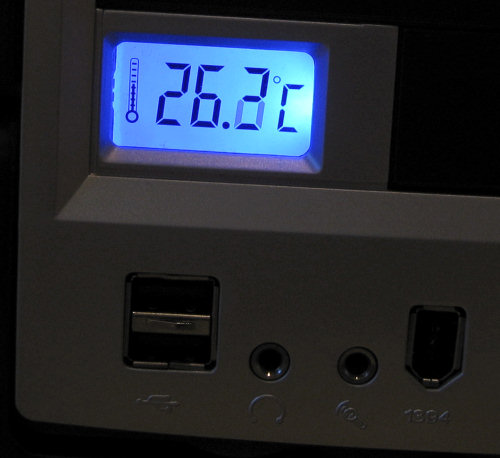
There isn't a whole lot to set the Ultra MicroFly apart from other similar micro-ATX cases, but it still represents a well-designed unit. The low cost of entry is definitely one of the most attractive aspects, and as a whole setting up and using the Ultra MicroFly was uneventful. As you'll see in a moment, the overall performance characteristics of the MicroFly are impressive, with the only potential blemish being slightly higher noise levels at full load.
Our first step with the MicroFly's install was putting the hard drive and assembled motherboard into their respective trays.
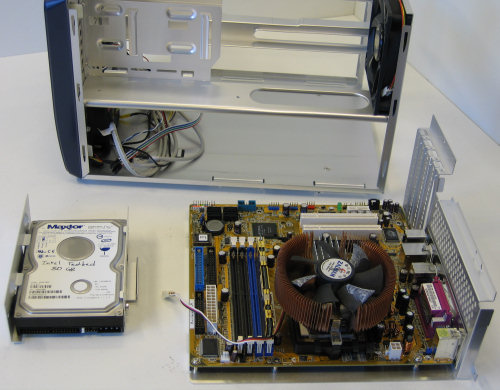 |
| Click to enlarge |
Like the other clones of this case, the MicroFly just barely works with our CNPS 7000 Cu cooler.
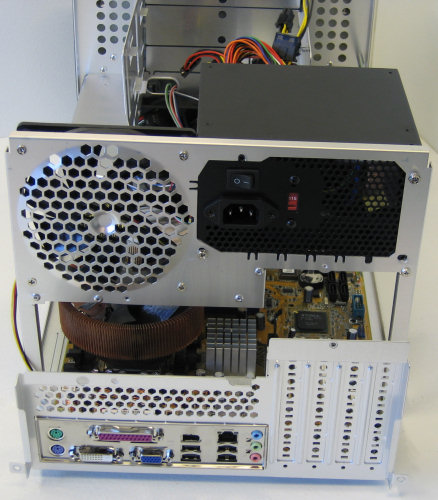 |
| Click to enlarge |
After making sure our CPU cooler would fit, we attached the video card with the single standard case screw and slid the completed motherboard tray into the case all the way. The largest video cards could be difficult to squeeze into the MicroFly, but it handles them better than the Aria.
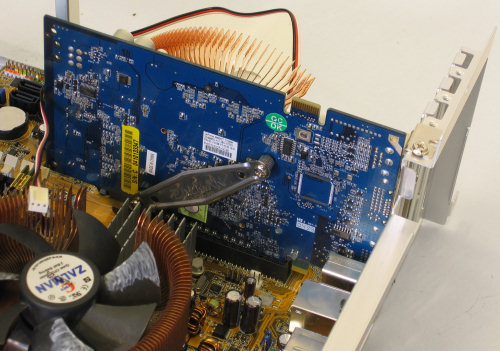 |
| Click to enlarge |
The included power supply has enough wires for most anything you could fit inside the case, including two 12 volt fan headers
 |
| Click to enlarge |
Our completed build from the right side. Like the other cases, there is still a little room for extra equipment in the front bottom, but unlike them there's actually a little space next to the PSU too, so with a little creativity a specialized water-cooling setup could be realized in this case as well.
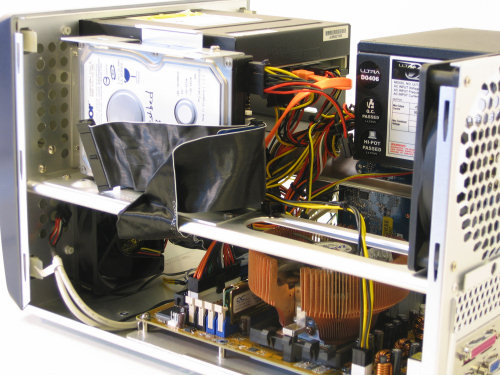 |
| Click to enlarge |
The LCD display on front shows the temperatures detected by the remote sensor which we attached loosely to our Zalman CPU cooler.

There isn't a whole lot to set the Ultra MicroFly apart from other similar micro-ATX cases, but it still represents a well-designed unit. The low cost of entry is definitely one of the most attractive aspects, and as a whole setting up and using the Ultra MicroFly was uneventful. As you'll see in a moment, the overall performance characteristics of the MicroFly are impressive, with the only potential blemish being slightly higher noise levels at full load.










37 Comments
View All Comments
jmke - Wednesday, January 3, 2007 - link
Do you have a picture of your test room? 15dB (I guess A weighed) seems awfully low :)JoshuaBuss - Wednesday, January 3, 2007 - link
It is very low.. in our old location we couldn't get any lower than 23 dB and now we're further away from the highway. All I know is that's what my new meter says if everything is silent and the dogs next door aren't barking.JoshuaBuss - Wednesday, January 3, 2007 - link
Whoa, I'm sorry.. it was supposed to be 18 dB. Updated.KayKay - Tuesday, January 2, 2007 - link
I built a machine for my brother using the Ultra microfly and it is a great case. The deciding factors for this was the ability to accept a Full-Size Power supply and the removable motherboard tray. They make this in several colours, as well as clear-sided versions. A small box with the ability to put some powerful components in it! 3800x2 with a 7600GT, this thing runs super quietCuriousMike - Tuesday, January 2, 2007 - link
I *just* built a machine three days ago using the Aria (NSK1300) as the basis; I just wanted something smaller than a tower case. I didn't see the review mention the case as being the NSK1300--- the Aria (IIRC) was all black. The case you reviewed is identical to the NSK1300.My build included a Frys X2 4200 "EE" combo deal with ECS C51GM motherboard.
The retail box AMD fan must have been running full tilt all the time (3000rpm sound right?)... it was the noisiest in the case. The CPU would reach 70' under Prime95 load within about 20 minutes, idleing at around 50'.
I replaced the stock HSF with a Zalman CNPS8000, which was reviewed poorer than the 7000 used in this review. The 8000, at anything other than it's lowest fan setting, is as loud as the AMD retail unit; at it's lowest fan setting, it *just* beats the cooling capacity of the stock HSF; running around 50' idle, and 69' with Prime load.
With the 8000 at full RPM, it only knocks a few degrees... 67'. The machine runs hot.
I used a evga 7600GTS and put a zalman 7000 GPU cooler on it (using the slowest fan setting); that made it go from idleing around 54' to 48', and running ATITool for 15 minutes, stock fan was 71', zalman brought it down to 65'.
With the current fan setup, the machine is tolerable noise wise. It's nowhere near silent.
The NSK1300 is cramped... almost impossible to route cables neatly.
It's pretty slick removing all the panels and the drive cage.
Myrandex - Tuesday, January 2, 2007 - link
I have the Lian Li PC-V300 and given its popularity with this crowd, I would have loved to see it included in there. I look forward to finishing the article as it is great so far.JoshuaBuss - Tuesday, January 2, 2007 - link
There are still a few more mATX cases on deck to be looked at soon.. hopefully the V300 will be one of them too.tayhimself - Tuesday, January 2, 2007 - link
I can't for the life of me find a good uATX motherboard with decent overclocking features for a core2 chip. I would like to build a uATX system but I havent gone with one because of the motherboards.Staples - Tuesday, January 2, 2007 - link
Unfortunately, good motherboards are not made in this size or even micro ATX for that matter. There are some decent P965 boards made in micro ATX sizes but the best ones are all in full sized ATX.JarredWalton - Tuesday, January 2, 2007 - link
µATX, uATX, mATX, and micro ATX are all the same thing. (u is the abbreviation used for mu a lot of the time - m already being taken by "milli" and most people not want to bother with the special symbol µ.)